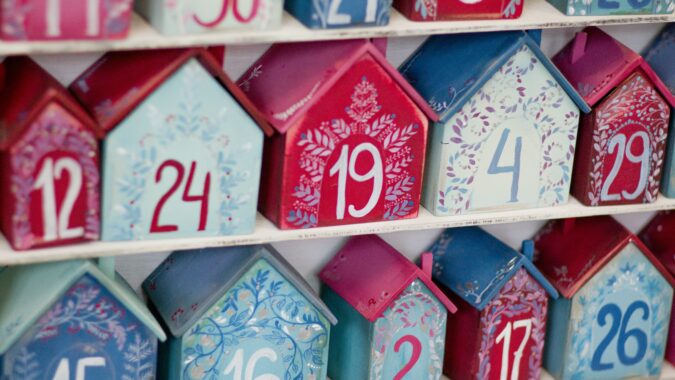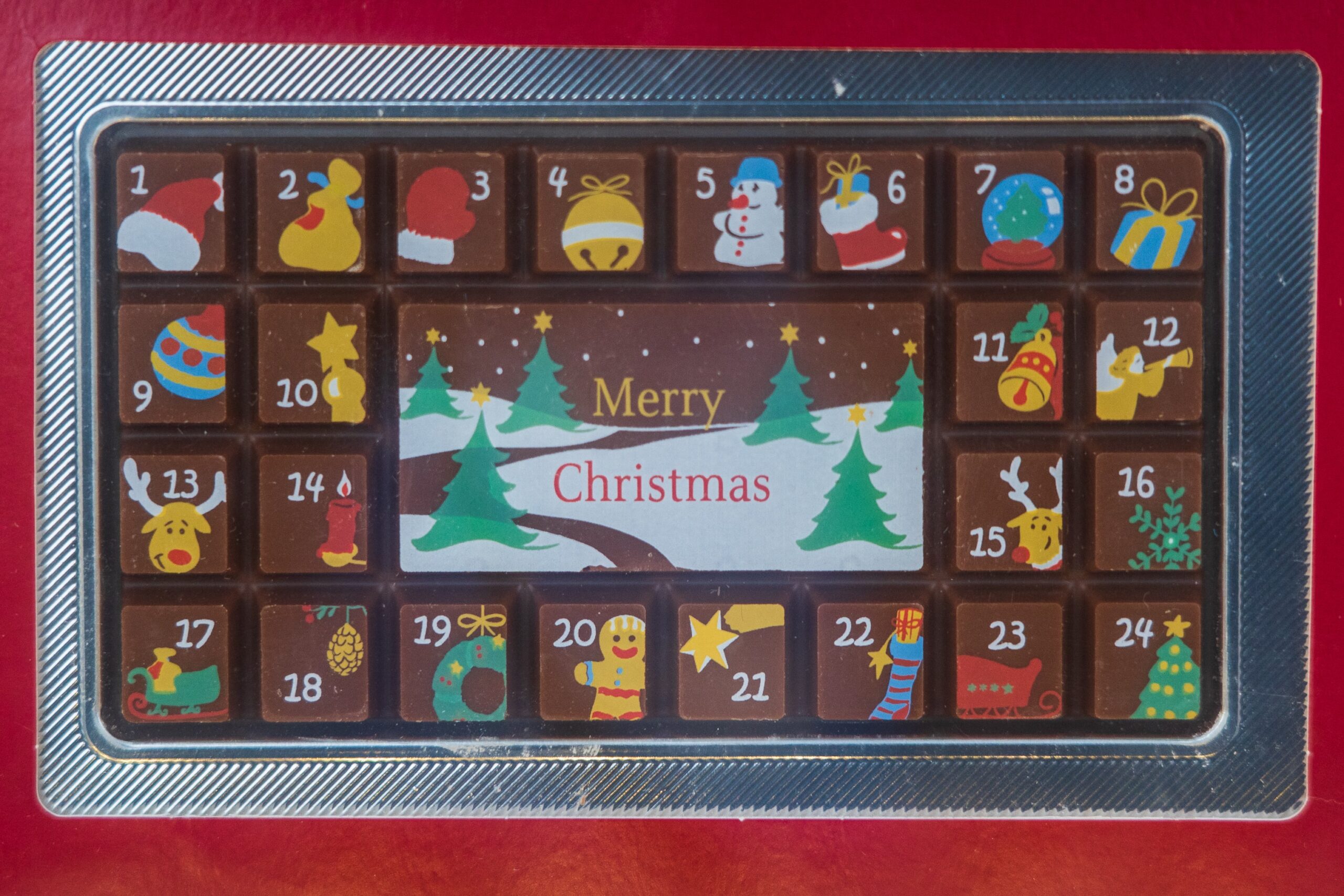How to Recycle and Reuse Advent Calendars
The good old days of traditional card advent calendars are pretty much over. Pulling back a little paper door and seeing an image of a donkey in a stable just doesn’t cut it for kids these days. They need advent calendars packed with chocolate, sweets, and toys. The problem is the extra plastic waste modern advent calendars creates.
And in recent years there’s been a growing trend for more outlandish advent calendars aimed at big kids (adults) as well. Advent calendars for beer, gin, coffee capsules, beauty products, chili sauce, even pork scratchings, all exist. These also introduce extra packaging and materials that make recycling advent calendars tricky.
There are solutions with many sustainable and plastic free advent calendars available, as well as ways to reduce the waste leftover from any advent calendar you or your children have this year. Learn how to recycle and reuse advent calendars this festive season.

Advent calendar facts
There are plenty of advent calendar facts out there about how it came to be a thing and where the biggest or smallest ever novelty advent calendar was made. But what about the waste they create? It’s not just a modern concern – during World War Two the production of advent calendars was stopped to save paper.
You might think their production should be stopped again (or at least changes made to advent calendar packaging) when you read these facts about the advent calendar and the waste it creates:
- Around 5 million advent calendars contain single-use plastics.
- The average traditional chocolate advent calendar is made from 7g of paper, 21.61g of PET plastic and 3.22g of aluminium.
- An advent calendar has around 38 times as much packaging per gram of chocolate compared to a standard chocolate bar.
- There’s also about 12 times as much plastic in an advent calendar compared to a regular bar of chocolate.
- The first advent calendar was produced in 1851 by hand and made from wood – much more sustainable than many modern ones.
- It wasn’t until around 1908 that the idea for a printed advent calendar was born.
Can advent calendars be recycled?
Traditional advent calendars are made from a combination of different materials. Separate the advent calendar and you can recycle the outer cardboard box in your domestic recycling bin. Check the plastic tray for a number and see if that type of plastic is accepted in your household recycling bin.
If the plastic tray is made from PET (1), HDPE (2), or PP (5) then there’s more chance of it being recyclable. This needs to be clean and dry to recycle though. Plastic trays from advent calendars made from other plastic types are less likely to be recyclable and should be disposed of with general waste.
The foil from advent calendars is also recyclable but it must be clean too. If there are bits of chocolate stuck to it this could contaminate the load. So, while you might not be able to recycle a complete advent calendar whole, breaking it down into recyclable parts offers the next best solution.

How to recycle an advent calendar
Once you’ve scoffed the last chocolate, built the last LEGO toy, or necked the final mini gin from your advent calendar (we won’t judge that it’s 9am on Christmas Day), you’ll want to throw away the box. But don’t just chuck it in with your general waste or recycling bin. There are three simple steps to recycle your advent calendar:
- Separate the advent calendar – most advent calendars are made from a mix of materials. Split them up into the cardboard, paper, plastic, foil, and any other materials for recycling and disposal with their relevant waste streams.
- Check and clean – check if the materials are recyclable (especially any plastics), then remove any food, dirt, or other contaminants and ensure it’s dry.
- Recycle – place the waste in your domestic recycling bin if it’s a type that’s accepted or in a specific cardboard recycling or plastic waste bin.
What can I do with an empty advent calendar?
If you find some of the materials in your empty advent calendar aren’t recyclable, don’t despair. There are many things you can do with the materials to reuse them and ensure it ends up being a more sustainable advent calendar anyway. Try the following things to do with an empty advent calendar:
- Refill and reuse – clean the plastic tray, melt some chocolate, and you’ve got some festive-shaped little chocolates. If the cardboard box and doors weren’t ripped off in excitement opening them, you might be able to reclose them with an adhesive or sticky tape to reuse the advent calendar next year.
- Make decorations – most advent calendars can’t be reused but you can cut out bits of the cardboard designs to make decorations. Put together paper chains, Christmas tree decorations, or wall hangers from the box.
- Create Christmas cards – if there are any characters or design elements intact from your empty advent calendar you can cut them out and stick on some card to make a unique Christmas card. It’s never too early to prepare for next Christmas!
- Gift tags and placeholders – make some last-minute gift tags or placeholders ready for Christmas dinner with your empty advent calendar. Cut out a square or rectangle from the cardboard and write your message or name on the back. It can then be recycled when the day is done.
- Craft confetti – when there’s not much of the design that’s salvageable from your advent calendar you could always shred it to form confetti for any upcoming celebrations, such as New Year.

Sustainable advent calendar ideas
An easy way to reduce the waste you create over the holiday season is with alternative ideas for sustainable and plastic-free advent calendars, instead of the traditional varieties. This avoids ending up with plastic and other waste that can’t be recycled on Christmas Day. Consider these sustainable advent calendar ideas:
- DIY advent calendars – the easiest way to have a plastic free advent calendar is to make your own. Use 24 old boxes, jam jars, cans, coffee tins, or anything else you can find for every window. Then fill each with a different gift to avoid creating any packaging waste. Plus, you can recycle all parts come Christmas.
- Beer advent calendars – obviously not for children, but most beer advent calendars are normally plastic free. With a cardboard box you can recycle and each gift a delicious beer in a recyclable metal can or glass bottle, this makes it highly sustainable.
- Seed advent calendars – highly eco-friendly options are seed advent calendars. The packaging is normally paper and cardboard that’s easily recycled, while planting the seeds helps you grow a variety of flowers, plants, and vegetables to keep the planet green.
- Reusable advent calendars – if you don’t have the time or creativity to make your own you could buy a reusable advent calendar. These are normally hung on a wall or door and feature 24 pockets that you can hide your own treats in to further avoid packaging waste. Plus, you can use it again next year, and the one after.
- Candle advent calendar – for something old school, why not go back to a candle advent candle? This could be either a candle you burn down to the relevant number every day or one that you just cross off each day when it burns. You can reuse the jar when it’s all melted away by Christmas.
Interested in more ways to reduce your waste over the festive season? Our detailed waste guides include hints, tricks, and tips for everything from Christmas dinner to gift wrapping and Christmas trees.
Have your waste collected
Get a fast FREE quote for your waste collection 0800 211 83 90
- Free quote within 1 hr
- Any type of waste
- FREE bins and delivery
- We cover all of the UK